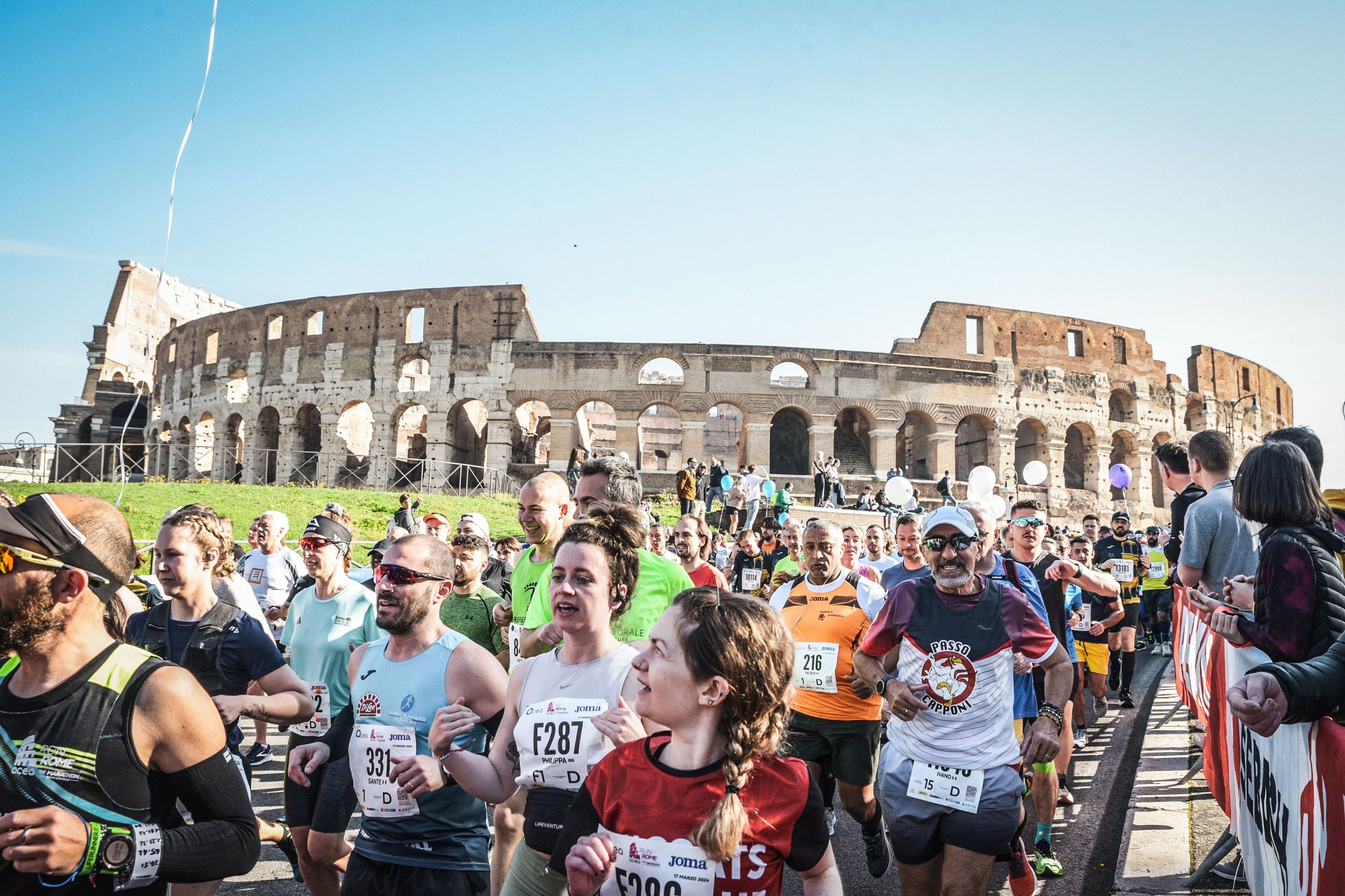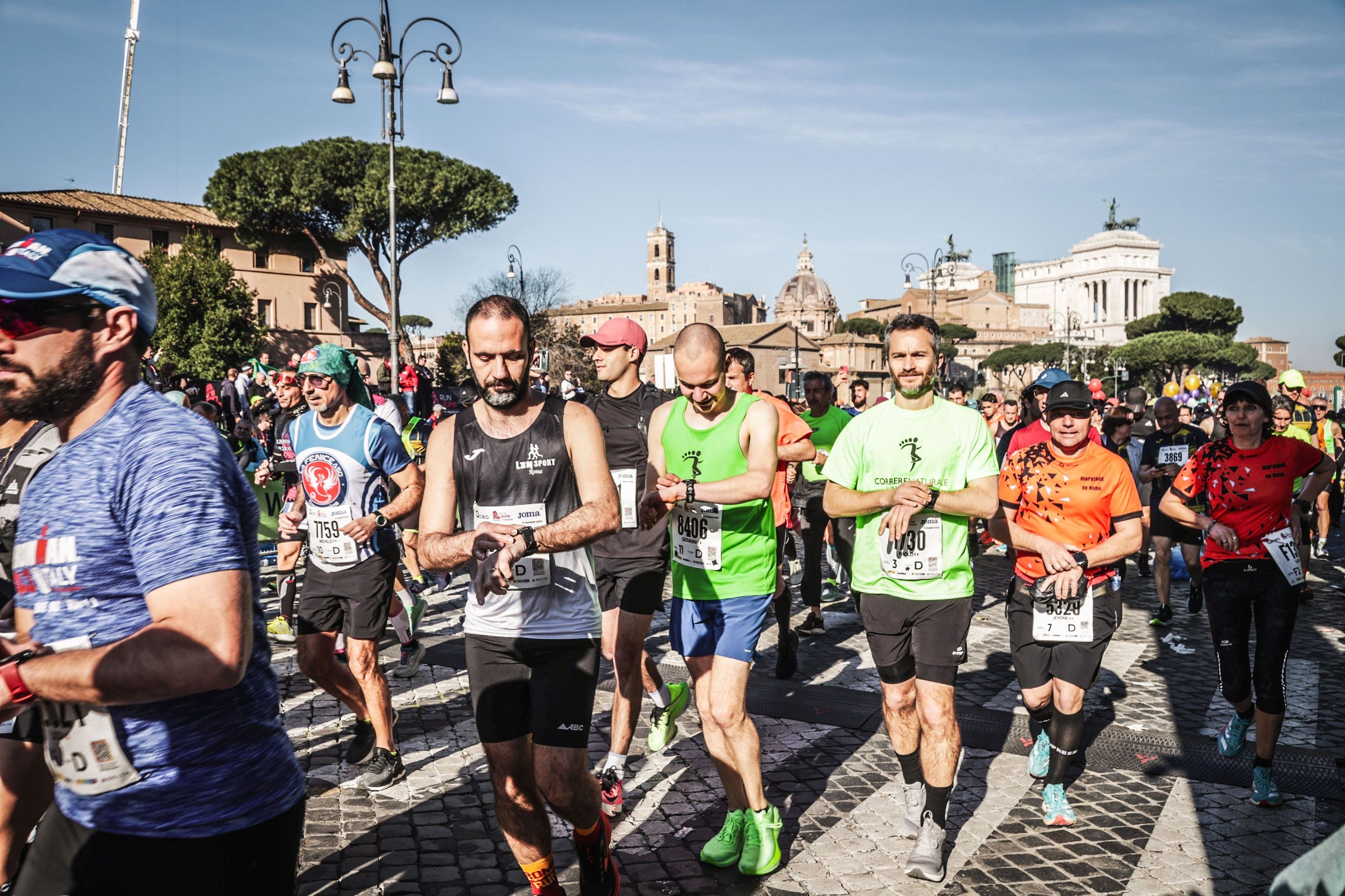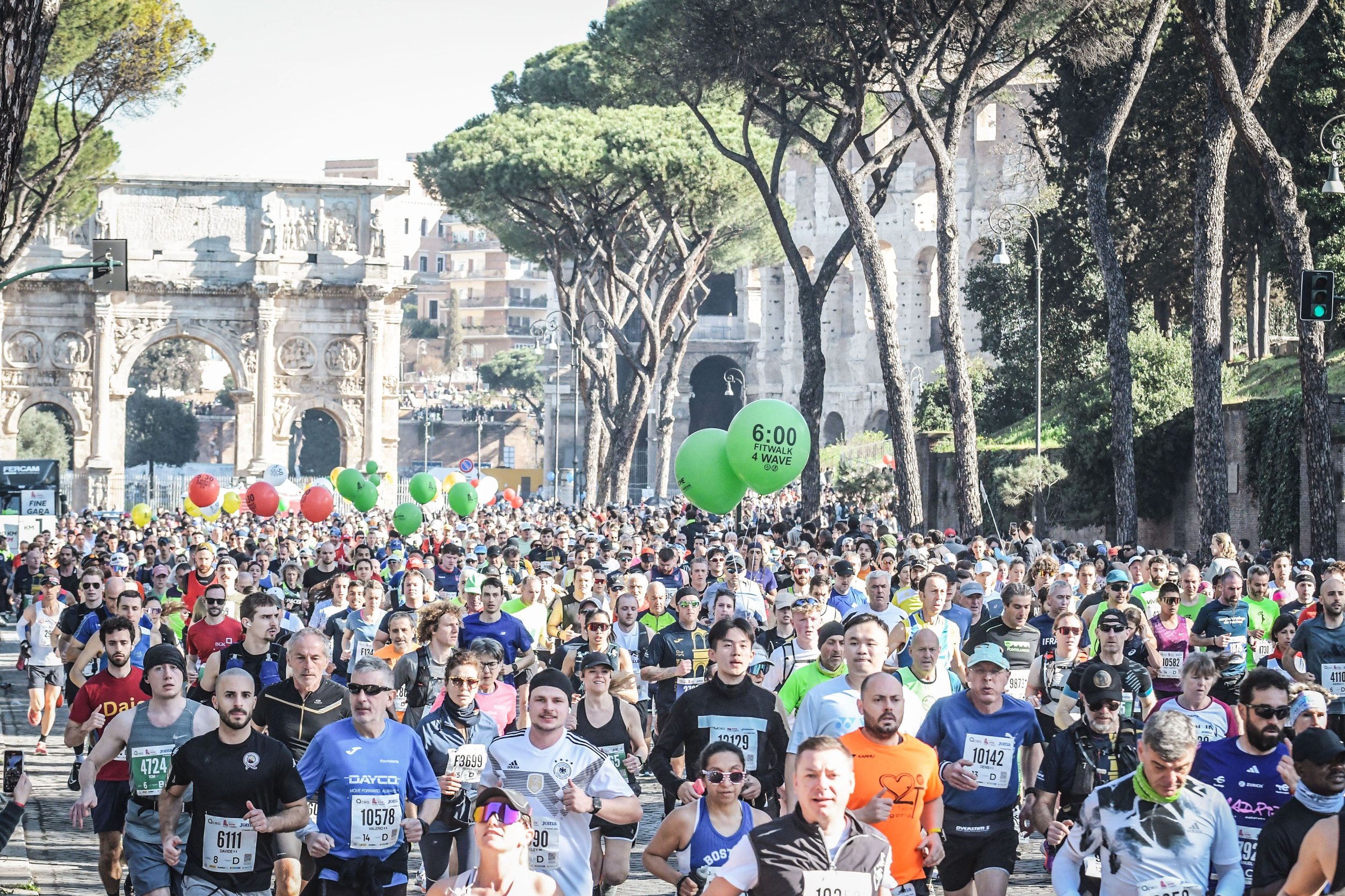My Rome Marathon With Type-1 Diabetes - Full Review
Three months after my first marathon, I’ve decided this is lots of fun. So I had to do another one: I’ve run the Rome Marathon, and it’s been epic!
A wonderful day, a crowd more energetic than ever, the sun shining, the sky blue with no cloud in sight.
As if the buzz was not enough already, right upon toeing the starting line a hand tapped my shoulder and a friend, smiling at me, called my name. Yes, you read that right: a friend casually found me among 40000 other people. A little chat was enough for us to understand that we had to share that race to bring the day up a level from “epic” to “perfect”.
And so we did! We shared the largest part of the first 30 kilometres - I then decided to pick up the pace just a slight in the last quarter of the race. Everything about this marathon was superlative, from the organisation to the course to the crowd, and I’ll offer a full account in the lines that follow.
I will also cover my nutrition and diabetes management strategy. Type 1 Diabetes taught me some big lessons this time around, and this article is needed for me to cherish the Marathon as much as to unpack what went wrong with my blood glucose.
The first paragraph is a full account of my marathon experience.
In the second paragraph I dive into my diabetes management strategy, and some errors I did.
If you have questions or want some extra details about what I ate and why, shoot them in the comments!
Let’s get stuck in!
The Rome Marathon: Epic And Beautiful
I don’t think I have to convince anybody that Rome is a beautiful city, that is just the undeniable truth everyone agrees on. I had been in Rome several times before in my life as a tourist or a casual visitor, and had loved every bit of it.
However, running its streets in such a festive atmosphere completely altered the way I experienced the city for the better. I really felt like I was absorbing it, soaking into it, appreciating it deeply.
Start At The Colusseum
We gathered around the starting gates close to the starting line in Via dei Fori Imperiali before 7.30, one full hour before the start. The weather forecast was perfect, so I decided to run with a singlet.
My initial concern of freezing during the wait was quick to vanish. It’s true it is the beginning of March, but there’s nothing truer than that warm sun above our heads.
The Elite athletes started at 8.30 am sharp, while me and my group only put our legs in motion at 8.51 am. From then on it’s a full 42 kilometres of astonishment, great buildings, constructions and historical monuments popping out from every angle.
The eyes had their share of beauty, and rest assured that so did the ears! Music bands, singing groups and DJs were providing the energy boost with excellent timing. The crowd filled the sidelines for nearly the whole course, except for a few smaller traits in between more central areas of the city.
Organized Water/Electrolytes Stations
Refreshments were served at a perfect cadence. I was prepared to meet them once every 5 kilometres, but I had the impression they were set up even more frequently. Electrolytes and water were enough for everyone and I was never stuck at one hydration point for more than a few seconds. Solids like bananas, apples and some biscuits were also up for grabs in most cases, although I chose to not eat any because I already had my gels and didn’t want to surprise my stomach with anything else.
Water and electrolytes were great, but what really made the difference were the sponges soaked in water provided by the volunteers. I wasn’t expecting such a warm sun and heat, so those turned out to be absolutely critical to prevent the nervous system from going bonkers and keep the perceived effort within acceptable parameters.
Marathon Best Moments And Watch-outs
The first best moment was right at the start. Perhaps it was the way the sun hit the Colusseum, or the fact that I was surrounded by an immense crowd of happy people, but kilometre 0 was magic. We all knew we were in for a ride, but we were excited.
By the way, do you also want to achieve and maintain
a 90% (or more!) time in range?
I have listed The 5 Pillars of my strategy,
grounded in science and experience, in a Free PDF.
The second best moment was right before San Peter’s Square. I knew it was part of the course but I had completely forgotten about it until the very moment I turned the corner and had it right in front of me in all of its immensity and majesty. I don’t know if a picture of me was taken at that moment, but I am pretty sure my jaw dropped all the way to the ground.
The third best moment lasted from kilometre 35 onwards. The final stretch of the Rome Marathon almost felt like a victory lap right in the crowded streets of downtown Rome. We passed Piazza Di Spagna, Piazza Navona, and so many other iconic places that I can’t quite recall them all here - I was lost into it and too focused on my running craft to rationalise.
The fourth and final best moment has to be the finish line. There’s something about crossing the finish line of a marathon under the Coliseum that makes it quite unique. Approaching it from afar, seeing it become larger and larger, sensing that you’ve done it, your chest enlarging with pride, the feeling of having “conquered Rome”, of having won a big battle just like the folks living there two thousands years ago…it could be me overstating it, but that was nothing short of fantastic.
The only watch out I have for anyone planning to run in the Eternal City in the future is to mind the cobblestones and the frequent ups and downs in the final portion - my memory could fail me, but these became tangible to me in the last 5 or 6 kilometres.
I had crafted a nice race plan and the intention was to pick up the pace in the last 10 kilometres. My energies were up for the challenge but every attempt to accelerate was partially frustrated by the increasing irregularities and small hills that were enough to force me to reconsider my decision. I still had a nice negative split, although less prominent than I expected.
My quadriceps were slightly sore from all that running downhill, but nothing that kept me from running the day after or from comfortably doing the stairs.
At the finish line! Wearing my CGM with pride.
The cobblestones were also a concern at the beginning. Many runners swear that they “kill your calves”, but with enough care for your pace and running technique you shouldn’t have any problem. I didn’t for sure!
Diabetes Management: The Only Pitfall, But Mastering Diabetes Nonetheless!
Diabetes Management was the only “pain point”. Don’t get me wrong, the weekend and the marathon experience were still superlative and nothing will affect this judgement. There is so much more in life than our dear diabetes measurements and metrics after all.
However, this being a blog about mastering diabetes and running, I must offer a full account of what happened - to you to learn from my mistakes, to myself to understand what I missed.
Despite all the care, all the calculations and the painstaking effort put into crafting the perfect nutrition and blood glucose management strategy, my body decided to go its own way and serve a few surprises. When this occurs, we just have to observe and learn.
A few hours of craziness!
How did I carb load to achieve the best blood glucose during the race?
I had crafted my nutrition plan to get me to the start line with a blood glucose of 180. For this, I used the biggest asset in my diabetes management toolkit: my Decision Tree journal.
In the days prior to the event I calculated that I would need around 700 grams of carbohydrates per day.
As always, I mostly ate fruit and leafy greens throughout the week to keep my blood glucose in range and avoid spikes.
Then I went all-in on potatoes and rice in the 24 hours leading up to the marathon to cut the fibres and avoid stomach troubles.
That worked, because when I woke up on race day (I can’t really say I slept at all, but that's details!) my CGM indicated the values I was seeking - fluctuating around 150, a slight higher than normal.
Three hours before the start I ate a small 50 grams-of-carbs breakfast of rice cakes and cornflakes just to top up the stores, injecting only half of the amount of insulin* I’d normally use for that amount. That elevated my blood glucose to the level I had planned, and I started the race at 193. Perfect!
Except that from the first kilometre it went on a steep climb that lifted it all the way up to 350, where it sat for nearly the entire four hours and fifty minutes it took me to run the full length.
So, what happened?
As weird as this sounds, I had a sensation this was going to happen. I had already noticed that my insulin requirements were increasing, signalling some mounting insulin resistance, but I was still surprised by the magnitude of my blood glucose elevation.
Looking back, I’ve come up with some hypotheses to make sense of it.
First of all, the excitement of running in Rome with 40000 other runners must have had some impact. I can’t explain the rise in blood glucose that occurred right at 8.30 AM (the start of the marathon) in any other way. The music, the buzz and the adrenaline all compounded on each other and, as we know, strong emotions do affect blood glucose. I also ate a few extra rice cakes right before the start (don’t ask me why, I don’t know! I was probably too excited and I just ate out of excitement.)
Then, I must account for the incredible and partially unexpected heat that surprised us all on the day. We all knew it was going to be sunny, but I was certainly not expecting to come home with sunburns on my shoulders! Heat is a stress factor, which can contribute to rising blood glucose levels. Drinking water at any hydration station helped me tame it, but I definitely felt it. I even took less gels than I had planned (four instead of five), but the rise still occurred.
A typical pre-marathon breakfast: two or three rice cakes alone or with jam.
I never need or want more than this, the real carb loading is done throughout the entire week.
Also, do not forget that spring always induces some hormonal changes that can momentarily alter the processes inside us. I’ve always noticed a period of seven to ten days - when transitioning from fall to winter and from winter to spring - where all my ratios are out of any logic. Doses that worked until yesterday are not fit for the job anymore, unexpected rises and falls in my blood glucose levels, poorer quality sleep, some sickness. I don’t have hard evidence on this point, but I’ve seen it occur with incredible regularity each and every year since I’ve been a type 1 diabetic that I can at least bring it up as “anecdata”.
Lastly, and this is entirely my fault, I have been eating more yellow light foods than usual that have contributed to my insulin resistance. In my hotel breakfasts I have indulged in more soy milk, bread slices and jams than usual, and the effects of these choices were evident.
In the days after the marathon I went from 30 total units of insulin to 60, while eating relatively less carbohydrates than usual (I took a break from big portions after the big day. I wanted to rest and recover, and to me a slight reduction in calorie intake is part of a good recovery). In essence, I became one big insulin resistant unit for a few days! That is due to the combination of processed carbohydrates (bread and jam), fats and proteins (soy milk and other oily food items), and my big usual servings of fruits. I am not surprised that I have been more out of range than usual. I guess I let it go for a few days, and that is ok. Some rest, Non Sleep Deep Rest (Yoga Nidra), and good nutrition helped me get back on track with ease.
My time in range was definitely affected by that big spike (that’s why you see a -8% since prior 14 days).
But it was not smashed! My resilient organism was in range 83% nonetheless, which is still good to me!
Marathon (and Life) Success With Type-1 Diabetes
The point I want to stress is that I could cope with higher blood glucose levels for a few hours (and days) without derailing my overall time in range. My goal was to enjoy a great marathon and a great day without hypoglycemias interfering, and if that entailed raising my blood glucose a bit then so be it!
My time in range for the marathon week was 81%, which considering the higher (processed) carbs intake, the marathon itself and the wild blood glucose elevations I had is still a big success.
My ninety-days score is still 90%, so my mind is at peace.
When we set our health as our top 1 priority and 90% of our choices when it comes to how we live and how and what we eat are spot on, then we can afford to make some “sacrifice”, to “trade” some of them for the occasion. Eating whole plant based, carbohydrates rich and low fat foods 90% of the time has made my body an insulin sensitive machine which can stand the occasional hiccups of a big event that might alter that equilibrium. While marathons and big sport events are certainly part of these, everyday life can also serve us days that are tougher than others, which can impact our type 1 diabetes management. A tough day at the office, an intense family situation, some stress induced lack of sleep…you know what I mean!
If we strengthen our bodies through good habits and good intentional choices while we are in control, they will be resilient and stand the test of life when the hard times come.
This marathon was a success for me. Diabetes did not affect the experience in any way. If anything, I’ve come out of it more experienced, and taking notes and observing these facts made me a wiser expert of my own body and the variables that affect it. I know how to fix my strategies a slight better now, even if my blood glucose was at 350 for a few crazy hours.
How can this be a loss?
* My carb to insulin ratio from the day before was 30:1. This means that one unit would handle around 30 grams of carbs. I ate 50 grams, which would have required around 2 units. Since I was about to run 42 kilometers, I halved the ratio and only took 1 unit in order to elevate my blood glucose and run safely.








